Laptop Mag Verdict
This update to Toshiba's fast and attractive 13-inch notebook offers a responsive but pricey multitouch display.
Pros
- +
Stylish dark brown design
- +
Responsive multitouch display
- +
Good performance
- +
Comfortable keyboard
- +
Helpful eco utility
Cons
- -
Touchscreen adds significant cost, looks a bit washed out
- -
Heavier than non-touch version
- -
Small touchpad
- -
Dim webcam video
Why you can trust Laptop Mag
Editor's Note: Portions of this review were taken from our earlier review of the Toshiba Satellite U505 (U505-S2930).
How much are touch capabilities worth? Like the U505 we reviewed earlier this year, this notebook has an attractive brown design and plenty of speed. But unlike the other U505, which cost $799, this $1,049 version features a multitouch 13-inch display that's designed to take advantage of Windows 7's touch capabilities, plus Toshiba's own nifty touch apps. These features work well, but we think many consumers will think twice about paying the premium for touch.
Design
One thing's for sure: The U505 has a classy design, with a unique Texture Finish in Luxe Brown on the lid and deck. (Other color options include white and pink.) Sure, it's plastic, but it feels and looks elegant. We also like the chrome accents around the slot-loading DVD drive, keyboard, and lid, and the subtle backlit strip above the touchpad. The bezel of the display is a glossy black, but you won't have to whip out the polishing cloth much.
While measuring the same dimensions as the previous model (12.5 x 9.1 x 1.5 inches), our review unit checked in at 5.4 pounds, over half a pound heavier than the non-touch version of the U505 and the $999 MacBook (which is also thinner, at 1.1 inches). Still, it's light enough for students to tote to class and move from room to room.
Keyboard and Touchpad
The U505 sports a flat keyboard whose layout leaves a good bit of room on either side of the deck. The result is that some of the keys (like the right Shift key) are slightly undersized. However, we liked the feel of the keys themselves, and that there was very little flex. Touch typists will have no problem getting acclimated to the U505.
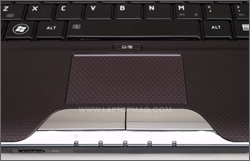
Click to enlargeWe're not fans of the tiny touchpad on the U505, which measures 2.5 x 1.6 inches. In fact, Toshiba's mini NB205 netbook has a much larger touchpad (3.1 x 1.6 inches). Navigating the desktop was smooth, but we wish we had more room. Then again, you have the option of using a touchscreen if you don't want to use the touchpad. We like the relatively large and solid mouse buttons, and the lock button for when you want to use an external mouse.
Loud Touch-Sensitive Controls
Above the keyboard are the two speakers and a row of touch-sensitive buttons, including the eco utility button, launch button for PowerCinema (similar to Media Center), and playback and volume controls. All of these buttons were responsive, but they emit a loud beep when pressed, which we found very annoying. The good news is that you can turn this beeping off by going into the HWSetup utility, although most users wouldn't know to do this.
Touchscreen Display and Audio
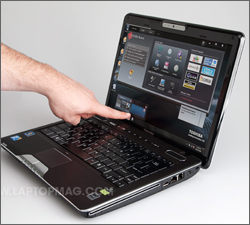
Click to enlarge
The U505 features a bright 13.3-inch display with 1280 x 800-pixel resolution, which means you can play 720p content. Compared to the non-touch version of the U505, we found that this model's touchscreen added a smoky sheen to images. Viewing angles were also diminished somewhat; while they were fairly good horizontally, tilting the screen even slightly forward tended to wash out pictures. Otherwise, color saturation and detail were acceptable when we streamed an episode of It's Always Sunny in Philadelphia from Hulu.
The U505 has a capacitive touchscreen, which means that it only responds to finger touches, and not a stylus. We found the screen to be fairly accurate and responsive when using Microsoft Surface Globe: we were able to quickly and smoothly rotate and zoom in on areas of the Earth.
The two speakers above the keyboard provided plenty of volume while watching that Hulu episode and while streaming a Green Day track from Slacker. We wouldn't max out the volume, however; the audio became somewhat distorted when playing music.
Touchscreen Applications
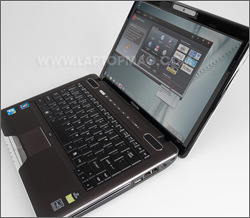
Click to enlarge
In addition to the Microsoft Touch Pack for Windows 7, Toshiba has included two of its own applications that take advantage of the touch screen.
Bulletin Board is just that: a window on the desktop where we could drag such things as notes, photos, and Web page links, "posting" them for later use. Once an item is placed on the bulletin board, a red thumbtack appears on top of it; by flicking the thumbtack away, the item disappears from the board. We were easily able to drag photos and videos onto the Bulletin Board, twisting and resizing them once they were attached; the touchcreen responded quickly to our gestures. However, the items on the Bulletin Board are only shortcuts. Double-tapping on a photo opened it in Windows Photo Viewer, and double-tapping a video launched it in Windows Media Player.
You can maximize the Bulletin Board so that it takes up about two-thirds of the whole screen; we would've liked if it could fill the entire display. A pencil tool lets you write on the bulletin board, but we presume this would be better suited for a Tablet PC. Also, the Bulletin Board works best for multimedia. Items such as Word docs only show up as icons, and don't even display the document's name beneath.
The other touch-enabled app that Toshiba includes is called Reel Time, which is accessed through the clock icon in the taskbar. Like a simpler version of Apple's Time Machine, it shows you previews, Aero Peek-style, of the files you had open on your desktop going back hours, days, or even months--a calendar lets you select specific dates. You can scroll along the timeline by using arrows at either end or by dragging the timeline itself, although the latter action tends to pop up documents that you didn't select.
The timeline can be customized to show everything you brought up, or just documents, pictures, videos, or only items used by a particular application. Unfortunately, the very act of looking at a screen from the past puts it in the present, so if you keep going back to a particular document, it will appear several times in the reel.
Ports, Webcam, and Facial Recognition
One stand-out feature of the U505 is its Sleep-and-Charge USB 2.0 port, which can charge your cell phone or other gear even when the system is powered down. Two USB 2.0 ports line the left side of the notebook, one of which doubling as an eSATA port for blazing backups to external drives equipped with that port. A VGA port, HDMI port, ExpressCard slot, and mic and headphone jacks are also on the left side. The third USB port, Ethernet and modem jacks, a slot for the DVD burner, and the lock slot line the right side of the U505. You'll find the memory card reader up front, along with a Wi-Fi on/off switch.
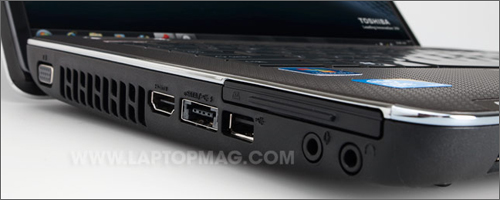
Click to enlarge
It's hard to miss the webcam on the U505, which is set off from the rest of the lid with a mirrored surface, complete with the words "Web Camera" printed to the right of the lens. When we made a video call to a coworker using Google Talk, he said we looked a little dark, which was surprising since we were sitting in an office with plenty of overhead and ambient light from a nearby window. Sound quality was clear in both directions.
Toshiba has obviously been working on improving its facial recognition feature for logging in, because we were successful on our first attempt (even if it takes a couple minutes to set up). After logging out, we clicked Start Face Recognition and were up and running in 12 seconds.
Performance
Equipped with a 2.1-GHz Intel Core 2 Duo T6600 processor and 4GB of RAM, the U505 has plenty of oomph to run Windows 7. In our PCMark Vantage test, which measures application performance, this machine turned in a score of 3,950, which is about 750 points above the older U505, 775 points above the $1,359 13-inch Sony VAIO SR, and 850 points above the average for thin-and-light notebooks. The U505 was bested by the HP Envy 13 in discrete mode, but only by 100 points--not bad, considering the Envy costs $800 more.
To test U505's multimedia prowess, we transcoded a 5:05 MPEG-4 clip to AVI using HandBrake. The system took 7 minutes and 27 seconds, nearly identical to the older U505 (7:25), and only slightly slower than the category average (7:17). Another 13-inch notebook in the same price range, the 2009 MacBook, took 6:50 when running Windows 7 in Boot Camp. Booting into Windows 7 Home Premium took 64 seconds on the U505, which is a few seconds slower than the category average.
On our LAPTOP Transfer Test, in which we copy 4.97GB folder of mixed media from one folder to another on the hard drive, the 5,400-rpm, 500GB hard drive inside U505 turned in a data rate of 22.1 MBps. That mark is slightly lower than the ASUS UL30A (23.2 MBps), but still well above the category average of 20.8 MBps. Plus, Toshiba includes a hard drive impact sensor to protect your data in case your system takes a tumble, a feature normally reserved for business notebooks.
Graphics Performance
Given that the U505 features integrated Intel GMA 4500MHD graphics, we don't recommend this laptop for gamers. Just look at the poor 6 frames per second the system turned in when playing Far Cry 2 with the resolution set to 1024 x 768, and graphics set to optimal. On the other hand, the U505's 3DMark06 score of 1,030 isn't too shabby. It's below the category average of 1,467, but higher than the HP Pavilion dm3t (703). It took about 13 seconds to fly to our Broadway address in New York City using Google Earth, and the animation was relatively smooth.
Battery Life and Wireless Performance
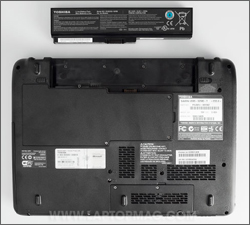
Click to enlarge
Using the standard six-cell battery, the U505 lasted 3 hours and 14 minutes on the LAPTOP Battery Test (continuous Web surfing over Wi-Fi). We're glad to see that the touchscreen only decreased the runtime over the non-touch version by 16 minutes, but it's still over an hour less than the thin-and-light average. If you want more endurance, spring for the larger twelve-cell battery, which costs an additional $85 if you configure your notebook on Toshiba's site. Toshiba claims this battery, which attaches to the bottom of the U505 and raises it by about 1 inch, will supply 7:30 to 8:00 hours of battery life, and will bring the weight of the notebook to an even 6.0 pounds.
Eco Mode and PC Health Monitor
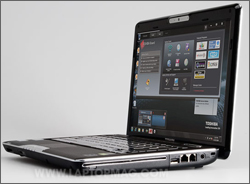
Click to enlarge
There are two other highlights to Toshiba's software bundle: the eco utility and PC Health Monitor. You activate the former software by pressing the eco button above the keyboard, which looks like a little Web globe with a stem attached. Within this software you can monitor your power consumption (measured in watts) in real time, as well as toggle eco mode on and off. When you turn eco mode on, you'll see that certain system properties get changed automatically, such as the display brightness level (from 8 for High Performance to 3), and when the display and hard disk get turned off (from 5 and 10 minutes, respectively, to 3 for each). Overall power consumption in High Performance mode averaged about 28 watts, versus 18 watts in eco mode.
The other noteworthy utility is PC Health Monitor, which can help you keep tabs on system functions such as power consumption, battery health, and system cooling. It also tells you the system temperature (we saw 38 percent of the max when unplugged), fan speed (58 percent in our tests), and the status of the hard disk drive sensor and hard drive itself.
Other Software and Warranty
The U505 includes a trial offer of Norton Internet Security 2009 (30 days) and Microsoft Office Home and Student 2007 (60 days). Other apps include Google Toolbar and Picasa, Corel DVD MovieFactory, and the WildTangent Orb Game Console for playing casual games. We could do without the "special offers" for Amazon.com shopping, NetZero, Skype, and Intuit QuickBooks, but they didn't hamper performance.
Toshiba backs the U505 with a one-year standard limited warranty and 24/7 toll-free tech support. To see how Toshiba fared in our Tech Support Showdown, click here.
Green Testing
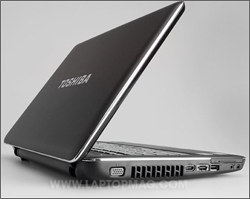
Click to enlarge
The U505 took 2 hours and 37 minutes to fully recharge its battery; during that time, it consumed 6923.7 watts of power. Its LAPTOP Battery Efficiency Rating (total watts divided by battery life) of 35.7 is pretty high for a thin-and-light notebook (the average is 27.1); still, its excellent EPEAT Rating of 22 (out of 27) is one of the highest we've seen.
Configuration and Upgrade Options
If you like the U505 but aren't sold on the touch capability, Toshiba sells a similar configuration of the notebook sans touchscreen, but with Nvidia GeForce G210M graphics, for $899 (U500-ST6322). If you decide to build your own U500 series on Toshiba's site, the company charges a whopping $191 for touch capability.
Toshiba makes the U500-ST6322 highly customizable. The 2.2-GHz Intel Core 2 Duo T6600 processor in our unit is at the lower end in terms of options. Customers can opt for as high as a 2.8-GHz Core 2 Duo T9600 CPU for $213 more. If you desire greater graphics performance, you can outfit the notebook with discrete Nvidia GeForce G210M graphics and 512MB of video memory. However, you have to decide between a touchscreen and graphics, note that the Nvidia GPU is not compatible with the touchscreen.
Also required for the touchscreen (although we're hard-pressed to figure out the reason) is the slot-loading DVD drive, the Texture Finish in Luxe Brown with Chrome Accents, and the LED-backlit keyboard. Without the touchscreen, a tray-loading DVD drive can be had for $30 less, and you can subtract the chrome accents for $33 off the final price. The 500GB hard drive included in our model is at the top of the spec list; you can opt for a drive as small as 250GB for $72 less.
Upgrading the U505 on your own is a cinch. A single panel on the back of the system with three small screws stands between you and the hard drive and memory slots.
Verdict
On the whole, the Toshiba U505-S2980-T is a pretty good Windows 7 touch notebook--and it offers a healthy dose of style along with plenty of muscle. However, at $1,049, this laptop is more expensive than a non-touchscreen version with better graphics. That's quite a lot to pay for a feature that results in a heavier chassis and a display that's less crisp. While it lacks a touchscreen, the redesigned unibdody MacBook, for $50 less, offers generally better performance and almost two additional hours of battery life in a sleeker design.
Toshiba U505 (U505-S2980-T) Specs
| Brand | Toshiba |
| CPU | 2.2-GHz Intel Core 2 Duo T6600 |
| Card Slots | 6-1 card reader, ExpressCard/54 |
| Company Website | http://www.toshibadirect.com |
| Display Size | 13.3 |
| Graphics Card | Intel GMA 4500MHD |
| Hard Drive Size | 500GB |
| Hard Drive Speed | 5,400rpm |
| Hard Drive Type | SATA Hard Drive |
| Native Resolution | 1280x800 |
| Operating System | MS Windows 7 Home Premium (64-bit) |
| Optical Drive | DVD SuperMultiDrive |
| Optical Drive Speed | 8X |
| Ports (excluding USB) | Headphone, HDMI, VGA, Ethernet, USB/eSATA, Modem, Microphone, Lock Slot |
| RAM | 4GB |
| RAM Upgradable to | 8GB |
| Size | 12.5 x 9.1 x 1.5 inches |
| USB Ports | 2 |
| Video Memory | 1.7GB |
| Warranty/Support | One-year limited/24/7 toll-free phone |
| Weight | 5.4 pounds |
| Wi-Fi | 802.11b/g/n |
Michael was the Reviews Editor at Laptop Mag. During his tenure at Laptop Mag, Michael reviewed some of the best laptops at the time, including notebooks from brands like Acer, Apple, Dell, Lenovo, and Asus. He wrote in-depth, hands-on guides about laptops that defined the world of tech, but he also stepped outside of the laptop world to talk about phones and wearables. He is now the U.S. Editor-in-Chief at our sister site Tom's Guide, where he oversees all evergreen content and the Homes, Smart Home, and Fitness/Wearables categories for the site..
